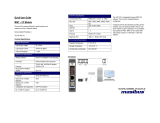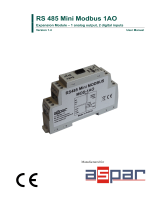
GN-9371_2_3 User Manual
Page 3 of (110)
G-series GN-9371_2_3 PIO Rev. 1.02.docx
Contents
1 Important Notes ....................................................................................................................................................... 5
Safety Instruction .............................................................................................................................................. 6
1.1.1 Symbols .......................................................................................................................................................... 6
1.1.2 Safety Notes ................................................................................................................................................... 6
1.1.3 Certifications .................................................................................................................................................. 6
2 G-Series System ....................................................................................................................................................... 7
2.1 Electrical Interface ............................................................................................................................................ 7
2.2 I/O Process Image Map ..................................................................................................................................... 8
3 Specification ............................................................................................................................................................. 9
3.1 General Specification ........................................................................................................................................ 9
3.2 Interface Specification ...................................................................................................................................... 10
3.3 GN-9371/9372/9373 Ethernet Connection Specification .................................................................................. 11
4 Module Description ................................................................................................................................................. 12
4.1 GN-9371/72/73 (MODBUS Programmable I/O) .............................................................................................. 12
4.2 LED Indicator ................................................................................................................................................... 13
4.2.1 Module Status LED (MOD) ........................................................................................................................... 13
4.2.2 Network Status LED (NET) ........................................................................................................................... 13
4.2.3 PLC Run/Stop Status LED (RUN) ................................................................................................................. 13
4.2.4 Extension Module Status LED (I/O) .............................................................................................................. 14
4.2.5 Field Power Status LED ................................................................................................................................. 14
RJ-45 Socket, RS232/485 Port .......................................................................................................................... 15
4.4 Toggle Switch, Push Button .............................................................................................................................. 15
4.5 RTB Terminal Block ......................................................................................................................................... 16
4.6 Pin Description.................................................................................................................................................. 16
4.7 Dimension (mm) ............................................................................................................................................... 17
5 Mechanical Setup .................................................................................................................................................... 18
5.1 How to mount on Din-Rail ................................................................................................................................ 18
5.2 How to dismount on Din-Rail ........................................................................................................................... 18
5.3 Removable Terminal Block (RTB) ................................................................................................................... 19
5.4 Method of Wiring ............................................................................................................................................. 19
6 G Series PIO (Programmable I/O) Functions ....................................................................................................... 20
6.1 Connection to IO Guide Pro by Modbus RTU *(RS-232 or RS-485) ............................................................... 20
6.2 Connection to IO Guide Pro by Modbus TCP .................................................................................................. 23
6.3 Confirmation of Network Information .............................................................................................................. 26
6.4 BOOTP / DHCP ................................................................................................................................................ 28
6.5 Setup IP Address ............................................................................................................................................... 30
6.6 Serial Communication Settings ......................................................................................................................... 33
6.7 Memory Reset ................................................................................................................................................... 35
6.8 RTC (Real Time Clock) Function ..................................................................................................................... 36
6.9 GN-9371/2/3 Webserver ................................................................................................................................... 37
6.10 IP Default Setting .............................................................................................................................................. 39
7 Programming the PIO (CODESYS) ...................................................................................................................... 40
7.1 Download and Install CODESYS ..................................................................................................................... 40
7.2 Basic Configuration CODESYS ....................................................................................................................... 40
7.2.1 Installation of XML ........................................................................................................................................ 40
7.2.2 Created Project ............................................................................................................................................... 42
7.2.3 CODESYS User Interface .............................................................................................................................. 43
7.2.4 Setup I/O ........................................................................................................................................................ 43
7.3 MODBUS TCP Setting ..................................................................................................................................... 45
7.3.1 TCP Master Setting ........................................................................................................................................ 45
7.3.2 TCP Slave Setting .......................................................................................................................................... 48
7.4 Network Variable .............................................................................................................................................. 50
7.5 Download and Monitoring ................................................................................................................................ 52
7.6 OPC Server (GN-9372/GN-9373 only)............................................................................................................. 53
7.7 Modbus RTU Master (GN-9372/GN-9373 only) .............................................................................................. 57
7.8 Web Visualization (GN-9373 only) .................................................................................................................. 61























